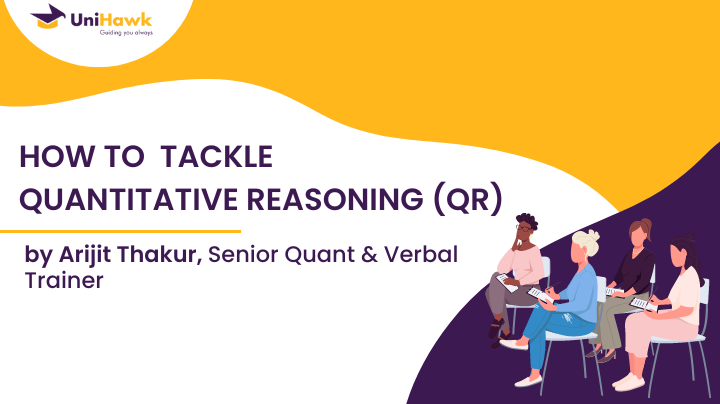In the “quantitative reasoning” section, you have to answer 36 questions in 25 minutes. These 36 questions make up 9 sets of 4 questions each. Every set of questions pertains to a body of information that is displayed in the upper half of the window when you view any question from the set. This format, combined with the fact that the real difficulty lies not in the mathematical operations that you need to perform but in the identification of numbers that you need to operate on, makes this section more a mathematical reading comprehension test than a math test.
The comprehension challenge – that is to say, the challenge to comprehend the information displayed in the upper half of the window – springs from the fact that this background information is often provided in a truly bewildering format. The question maker uses a variety of presentation methods – from graphs and pie charts to tables of different types. In a table, the figures may be stated in isolation in one column and cumulative in another. In short, the format is meant to cause confusion.
However, such confusion can be totally avoided by just getting to these types of graphs or tables and answering a good number of QR question sets in the months before you take the exam. Among mathematical concepts, only those pertaining to percentage calculation are relevant here. The most basic ones, like the idea that a percentage is nothing but a fraction multiplied with 100. Or that 100 should be in the denominator in some calculations and in the numerator in others.
Once you are equipped with these concepts and a high level of familiarity with those peculiar data presentation formats, you can start practicing question sets with an eye on increasing your speed. Remember: you have to answer 36 questions in 25 minutes. That leaves less than 42 seconds per question on average. To go at that speed, you need to decrease your dependence on the on-screen calculator that you have access to during the exam. That is the only calculating device you can access any time during the exam and that calculator is cumbersome, to say the least. Using it frequently slows you down.
To that effect, we recommend that you memorise number multiplication tables up until 19 times 9. That will allow you to multiply any two digit number with another two digit number or a one digit number manually in 5 seconds. You could then also do division involving 2 or 3 digit numbers manually. Even more time can be saved by memorising the correspondence between common fractions and percentages. For example, ½ = 50%; ⅓ = 33.3%; ⅔ = 66.6%; ¼ = 25%; ¾ = 75%; and so on. This is particularly important because nearly 60% of all the calculations you are required to perform are percentage calculations. And remembering is less prone to making mistakes than calculating is.
A special mention must be made of the problems that involve basic geometry and conversion of units. Often teachers assume that UCAT candidates are knowledgeable about calculation of area, volume, circumference and perimeter because those topics are part of the math syllabus in every secondary school. However, we at UniHawk like to make sure that 11th or 12th standard students remember things they studied 3 or 4 years ago. It is not safe to rely on assumptions here.
The conversion of units tests your understanding of equations – how to transfer an element from one side of the equation to the other, to be precise. You must be careful of the distinctions among converting a unit, converting a square unit and converting a cubic unit. There is only one type of unit conversion question that does not relate to the concept of equations. It is the questions that relate to the local time in different places. These are figured out by simple additions and subtractions.
Overall, this is a math test that does not disadvantage candidates who were not champion mathematicians at school. All it takes to do well in this section is that the candidate does not panic at the sight of numbers and lots of practice. As that quintessentially English proverb says, familiarity breeds contempt. You will begin to view the QR section as something of a subordinate order once you have practiced enough sets.
by Arijit Thakur, Senior Quant & Verbal Trainer





